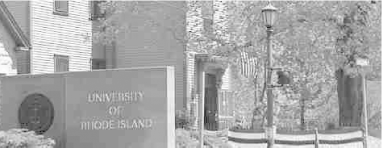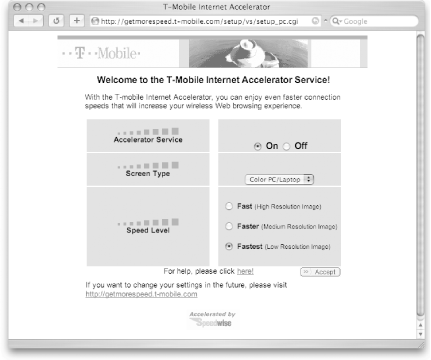7.5 Acceleration
Although GPRS and CDMA can reach speeds close to or faster than a regular dial-up Internet connection, they can't compete with a good solid Wi-Fi connection. But they can get slightly closer by putting a little intelligence between your notebook and the Internet. Cellular providers accomplish this in two ways: client-server compressing proxies require you to run a small client program on your desktop to communicate with a server responsible for compressing content you load from the Internet; transparent accelerators silently intercept and modify web content so that it loads faster on your computer.
Your mileage may vary using either type of acceleration: sometimes it speeds things up, but you can also end up waiting so long for the accelerator to do its processing that it's better to not use it. You should try acceleration and see how it works; your cellular provider should be able to tell you how to turn this feature on or off.
7.5.1 Client-Server Compressing Proxies
Verizon Wireless and AT&T Wireless support this kind of accelerator. The process involves two pieces of middleware that sit between your web browser and the Internet, a client and a server.
- The compressing proxy server
-
This is a proxy server that sits in your cellular carrier's "cloud" (somewhere on their network). When a request comes for an HTML file, graphic, or text file, this proxy server downloads the content, compresses it, and sends it back to whoever requested it (you).
- The client
-
Because your web browser doesn't understand the compression scheme used by the proxy server up in the cloud, you need to run a second piece of software on your computer. This is often referred to as a client, and is generally invisible to you. This client is actually a mini proxy server that accepts requests from your web browser, forwards them to the compressing server in the cloud, and decompresses the responses before sending them back to your browser.
At the time of this writing, no Mac OS X client is available for either of these compressing proxy servers. However, if you are an AT&T Wireless or Verizon Wireless customer, be sure to contact them and ask, in case this has changed (or at least to let them know the demand exists!).
7.5.2 Transparent Accelerators
Sprint and T-Mobile have transparent acceleration on their network. Unlike the previously described solutions, this is completely clientless; it transparently intercepts and compresses network traffic so that the images and documents received by your web browser are as small as possible. To do this, it reduces the quality of images and compresses HTML files before sending them on to your browser.
Figure 7-15 and Figure 7-16 show detail from an image that was compressed on T-Mobile's network using no compression and maximum compression. This 799 x 599 pixel image was originally 96k; after compression, it is only 48k.
Figure 7-15. Photograph with no compression

Figure 7-16. Photograph with maximum compression

In Figure 7-16, some artifacts are visible; even though the file size is roughly 50 percent of the uncompressed version, it is hard to tell the difference between the two. Figure 7-17 shows the T-Mobile Internet Accelerator configuration page (http://getmorespeed.t-mobile.com).
Figure 7-17. Configuring the T-Mobile Internet Accelerator







